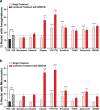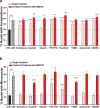A multiparametric screen uncovers FDA-approved small molecules that potentiate the nuclear mechano-dysfunctions in ATR-defective cells
- PMID: 39730498
- PMCID: PMC11680690
- DOI: 10.1038/s41598-024-80837-w
A multiparametric screen uncovers FDA-approved small molecules that potentiate the nuclear mechano-dysfunctions in ATR-defective cells
Abstract
Targeting nuclear mechanics is emerging as a promising therapeutic strategy for sensitizing cancer cells to immunotherapy. Inhibition of the mechano-sensory kinase ATR leads to mechanical vulnerability of cancer cells, causing nuclear envelope softness and collapse and activation of the cGAS-STING-mediated innate immune response. Finding novel compounds that interfere with the non-canonical role of ATR in controlling nuclear mechanics presents an intriguing therapeutic opportunity. We carried out a multiparametric high-content screen to identify small molecules that affect nuclear envelope shape and to uncover novel players that could either ameliorate or further compromise the nuclear mechanical abnormalities of ATR-defective cells. The screen was performed in HeLa cells genetically depleted for ATR. Candidate hits were also tested in combination with the chemical inhibition of ATR by AZD6738, and their efficacy was further validated in the triple-negative breast cancer cell lines BT549 and HCC1937. We show that those compounds enhancing the abnormal nuclear shape of ATR-defective cells also synergize with AZD6738 to boost the expression of interferon-stimulated genes, highlighting the power of multiparametric screens to identify novel combined therapeutic interventions targeting nuclear mechanics for cancer immunotherapy.
© 2024. The Author(s).
Conflict of interest statement
Declarations. Competing interests: The authors declare no competing interests.
Figures







Similar articles
-
The orally active and bioavailable ATR kinase inhibitor AZD6738 potentiates the anti-tumor effects of cisplatin to resolve ATM-deficient non-small cell lung cancer in vivo.Oncotarget. 2015 Dec 29;6(42):44289-305. doi: 10.18632/oncotarget.6247. Oncotarget. 2015. PMID: 26517239 Free PMC article.
-
ATR is essential for preservation of cell mechanics and nuclear integrity during interstitial migration.Nat Commun. 2020 Sep 24;11(1):4828. doi: 10.1038/s41467-020-18580-9. Nat Commun. 2020. PMID: 32973141 Free PMC article.
-
Combined PARP and ATR inhibition potentiates genome instability and cell death in ATM-deficient cancer cells.Oncogene. 2020 Jun;39(25):4869-4883. doi: 10.1038/s41388-020-1328-y. Epub 2020 May 23. Oncogene. 2020. PMID: 32444694 Free PMC article.
-
Targeting ATR Pathway in Solid Tumors: Evidence of Improving Therapeutic Outcomes.Int J Mol Sci. 2024 Feb 27;25(5):2767. doi: 10.3390/ijms25052767. Int J Mol Sci. 2024. PMID: 38474014 Free PMC article. Review.
-
ATR-mediated regulation of nuclear and cellular plasticity.DNA Repair (Amst). 2016 Aug;44:143-150. doi: 10.1016/j.dnarep.2016.05.020. Epub 2016 May 16. DNA Repair (Amst). 2016. PMID: 27283761 Free PMC article. Review.
References
-
- Bastianello, G. & Foiani, M. Mechanisms controlling the mechanical properties of the nuclei. Curr. Opin. Cell Biol.84, 102222. 10.1016/j.ceb.2023.102222 (2023). - PubMed
-
- Nader, G. P. F., Williart, A. & Piel, M. Nuclear deformations, from signaling to perturbation and damage. Curr. Opin. Cell Biol.72, 137–145. 10.1016/j.ceb.2021.07.008 (2021). - PubMed
MeSH terms
Substances
LinkOut - more resources
Full Text Sources
Research Materials
Miscellaneous

